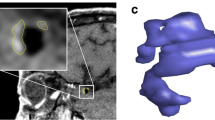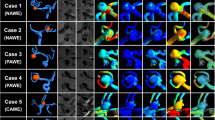Abstract
Purpose
This study aimed to evaluate new quantitative parameters of aneurysm wall enhancement (AWE) on magnetic resonance vessel wall imaging (VWI) in differentiating between the stable and evolving unruptured intracranial aneurysms (UIAs).
Methods
Thirty-eight consecutive patients with UIAs (27 stable and 11 evolving) underwent VWI with contrast-enhanced 3D T1 volume isotropic turbo spin echo acquisition. The voxel-based enhancement maps were created using pre- and post-contrast images. The aneurysmal lumen with signal suppression by black-blood method was segmented. Then, one voxel outer and inner layers of the lumen contour were automatically segmented. The shape features of the aneurysms and AWE of the two layers were compared between stable and evolving groups.
Results
The shape features, including aneurysm volume, surface, and compacity were significantly different between the stable and evolving groups (P = 0.024, 0.028, and 0.033, respectively). Stable and evolving groups also differed significantly in the AWE at the union of outer and inner layers of the aneurysm wall (P = 0.0082) but not in that of the outer or inner layer alone. Multivariate logistic regression analysis revealed significant differences in aneurysm volume, surface, and AWE at the union of outer and inner layers between the two groups (P = 0.0029, 0.0092, and 0.0033, respectively). Receiver operating characteristics curve analysis revealed that the area under the curve of the logistic regression model was 0.89.
Conclusion
Quantitative combined analysis of aneurysm shape features and AWE of the union of outer and inner layers were effective for differentiating between stable and evolving UIAs.



Similar content being viewed by others
Abbreviations
- AWE:
-
Aneurysm wall enhancement
- UIA:
-
Unruptured intracranial aneurysm
- VISTA:
-
Volume isotropic turbo spin echo acquisition
- VWI:
-
Vessel wall imaging
References
Vlak MH, Algra A, Brandenburg R, Rinkel GJ (2011) Prevalence of unruptured intracranial aneurysms, with emphasis on sex, age, comorbidity, country, and time period: a systematic review and meta-analysis. Lancet Neurol 10:626–636
The UCAS Japan Investigators (2012) The Natural course of unruptured cerebral aneurysms in a Japanese cohort. N Engl J Med 366:2474–2482
Algra AM, Lindgren A, Vergouwen MDI et al (2019) Procedural clinical complications, case-fatality risks, and risk factors in endovascular and neurosurgical treatment of unruptured intracranial aneurysms: a systematic review and meta-analysis. JAMA Neurol 76:282
Greving JP, Wermer MJH, Brown RD et al (2014) Development of the PHASES score for prediction of risk of rupture of intracranial aneurysms: a pooled analysis of six prospective cohort studies. Lancet Neurol 13:59–66
Tominari S, Morita A, Ishibashi T et al (2015) Prediction model for 3-year rupture risk of unruptured cerebral aneurysms in Japanese patients: cerebral aneurysm rupture risk. Ann Neurol 77:1050–1059
Brinjikji W, Zhu Y-Q, Lanzino G et al (2016) Risk factors for growth of intracranial aneurysms: a systematic review and meta-analysis. AJNR Am J Neuroradiol 37:615–620
Inoue T, Shimizu H, Fujimura M et al (2012) Annual rupture risk of growing unruptured cerebral aneurysms detected by magnetic resonance angiography: Clinical article. JNS 117:20–25
Omodaka S, Endo H, Niizuma K et al (2019) Circumferential wall enhancement in evolving intracranial aneurysms on magnetic resonance vessel wall imaging. J Neurosurg 131:1262–1268
Matsushige T, Shimonaga K, Ishii D et al (2019) Vessel wall imaging of evolving unruptured intracranial aneurysms. Stroke 50:1891–1894
Landis JR, Koch GG (1977) The measurement of observer agreement for categorical data. Biometrics 33:159
Omodaka S, Endo H, Niizuma K et al (2016) Quantitative Assessment of circumferential enhancement along the wall of cerebral aneurysms using MR imaging. Am J Neuroradiol 37:1262–1266
Nagahata S, Nagahata M, Obara M et al (2016) Wall enhancement of the intracranial aneurysms revealed by magnetic resonance vessel wall imaging using three-dimensional turbo spin-echo sequence with motion-sensitized driven-equilibrium: a sign of ruptured aneurysm? Clin Neuroradiol 26:277–283
Matouk CC, Mandell DM, Günel M et al (2013) Vessel wall magnetic resonance imaging identifies the site of rupture in patients with multiple intracranial aneurysms. Neurosurgery 72:492–496
Zhu C, Wang X, Eisenmenger L et al (2020) Wall enhancement on black-blood MRI is independently associated with symptomatic status of unruptured intracranial saccular aneurysm. Eur Radiol 30:6413–6420
Vergouwen MDI, Backes D, van der Schaaf IC et al (2019) Gadolinium Enhancement of the aneurysm wall in unruptured intracranial aneurysms is associated with an increased risk of aneurysm instability: a follow-up study. AJNR Am J Neuroradiol 40:1112–1116
Shimonaga K, Matsushige T, Ishii D et al (2018) Clinicopathological insights from vessel wall imaging of unruptured intracranial aneurysms. Stroke 49:2516–2519
Larsen N, Flüh C, Saalfeld S et al (2020) Multimodal validation of focal enhancement in intracranial aneurysms as a surrogate marker for aneurysm instability. Neuroradiology 62:1627–1635
Gariel F, Ben Hassen W, Boulouis G et al (2020) Increased wall enhancement during follow-up as a predictor of subsequent aneurysmal growth. Stroke 51:1868–1872
Edjlali M, Guédon A, Ben Hassen W et al (2018) Circumferential thick enhancement at vessel wall MRI has high specificity for intracranial aneurysm instability. Radiology 289(1):181–187. https://doi.org/10.1148/radiol.2018172879
Stember JN, Chang P, Stember DM et al (2019) Convolutional neural networks for the detection and measurement of cerebral aneurysms on magnetic resonance angiography. J Digit Imaging 32:808–815
Omodaka S, Endo H, Niizuma K et al (2018) Circumferential wall enhancement on magnetic resonance imaging is useful to identify rupture site in patients with multiple cerebral aneurysms. Neurosurgery 82:638–644
Tsuji M, Ishikawa T, Ishida F et al (2017) Stagnation and complex flow in ruptured cerebral aneurysms: a possible association with hemostatic pattern. J Neurosurg 126:1566–1572
Sugiyama S, Endo H, Niizuma K et al (2016) Computational hemodynamic analysis for the diagnosis of atherosclerotic changes in intracranial aneurysms: a proof-of-concept study using 3 cases harboring atherosclerotic and nonatherosclerotic aneurysms simultaneously. Comput Math Methods Med 2016:1–12
Sugiyama S, Niizuma K, Nakayama T et al (2013) Relative residence time prolongation in intracranial aneurysms: a possible association with atherosclerosis. Neurosurgery 73:767–776
Quan K, Song J, Yang Z et al (2019) Validation of wall enhancement as a new imaging biomarker of unruptured cerebral aneurysm. Stroke 50:1570–1573
Khan MO, Toro Arana V, Rubbert C et al (2021) Association between aneurysm hemodynamics and wall enhancement on 3D vessel wall MRI. J Neurosurg 134:565–575
Hokari M, Nakayama N, Nishihara H, Houkin K (2015) Pathological findings of saccular cerebral aneurysms—impact of subintimal fibrin deposition on aneurysm rupture. Neurosurg Rev 38:531–540
Chalouhi N, Hoh BL, Hasan D (2013) Review of cerebral aneurysm formation, growth, and rupture. Stroke 44:3613–3622
Sato T, Matsushige T, Chen B et al (2019) Wall contrast enhancement of thrombosed intracranial aneurysms at 7T MRI. AJNR Am J Neuroradiol 40:1106–1111
McDonald RJ, McDonald JS, Kallmes DF et al (2017) Gadolinium deposition in human brain tissues after contrast-enhanced MR imaging in adult patients without intracranial abnormalities. Radiology 285:546–554
Kleinloog R, Korkmaz E, Zwanenburg JJM et al (2014) Visualization of the aneurysm wall: a 7.0-tesla magnetic resonance imaging study. Neurosurgery 75:614–622
Acknowledgements
The authors thank Hiroaki Shimizu and Kenichi Higuchi in Tohoku University for their kind support.
Author information
Authors and Affiliations
Contributions
Conceptualization: [Naoko Mori], [Hidenori Endo]; methodology: [Shunji Mugikura], [Naoko Mori]; formal analysis and investigation: [Kuniyasu Niizuma], [Shunsuke Omodaka]; writing—original draft preparation: [Naoko Mori], [Hidenori Endo]; writing—review and editing: [Naoko Mori], [Teiji Tominaga]; Funding acquisition: [Naoko Mori]; resources: [Hidenori Endo], [Teiji Tominaga], [Kei Takase]; supervision: [Teiji Tominaga].
Corresponding author
Ethics declarations
Conflict of interest
The authors declare no competing interests.
Ethics approval
This study was approved by the institutional review board. The requirement for informed consent for this study was waived because of its retrospective design.
Consent to participate
The requirement for informed consent for this study was waived because of its retrospective design.
Consent for publication
The requirement for informed consent for this study was waived because of its retrospective design.
Additional information
Publisher's note
Springer Nature remains neutral with regard to jurisdictional claims in published maps and institutional affiliations.
Supplementary Information
Below is the link to the electronic supplementary material.
Rights and permissions
About this article
Cite this article
Endo, H., Mori, N., Mugikura, S. et al. Quantitative assessment of microstructural evolution of intracranial aneurysm wall by vessel wall imaging. Neuroradiology 64, 1343–1350 (2022). https://doi.org/10.1007/s00234-021-02877-7
Received:
Accepted:
Published:
Issue Date:
DOI: https://doi.org/10.1007/s00234-021-02877-7




